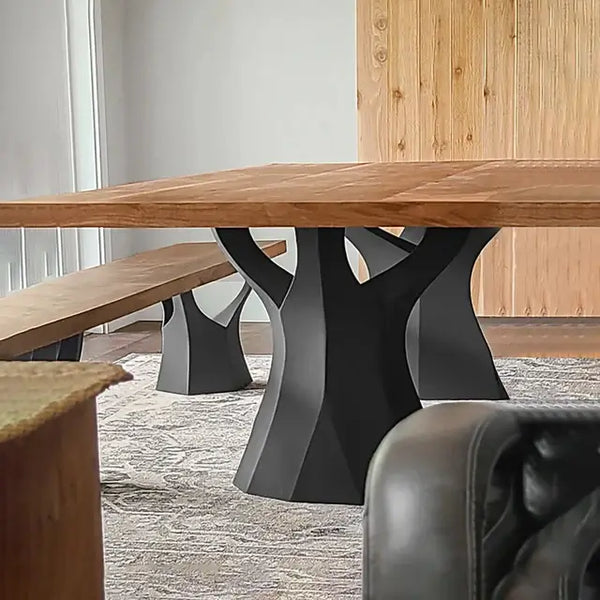From Typical to Modern: Discover the Ideal Eating Room Table Legs for Your Design
While classic styles such as cabriole and transformed legs stimulate a sense of ageless refinement, contemporary styles like hairpin and geometric alternatives offer an opportunity for striking visual passion. As you take into consideration these elements, the concern continues to be: just how can you seamlessly incorporate these diverse leg designs to produce an unified eating experience?
Comprehending Table Leg Styles
The range of dining-room table leg designs can substantially affect both the aesthetics and functionality of the space. Each leg style adds one-of-a-kind aesthetic components and sensible functions, catering to varied layout choices and usage requirements. Understanding these designs is critical for picking the ideal table that aligns with your overall interior decoration vision.
For example, tapered legs supply a tidy, traditional look that can boost a space's beauty, while stand bases give stability and optimize legroom, making them suitable for smaller areas. Barrette legs, a characteristic of mid-century contemporary design, present an industrial flair, permitting for an airy, open feel. Trestle legs evoke rustic charm, supplying robust assistance and a sense of eternity.
Furthermore, the selection of materials plays a significant function. Wooden legs can bring warmth and texture, whereas metal alternatives commonly share a smooth, modern ambiance. Inevitably, understanding table leg styles is essential for creating a natural dining location that mirrors personal design while ensuring usefulness and comfort. By thoughtfully taking into consideration these elements, you can enhance both the useful and aesthetic appeal of your dining room.
Conventional Table Leg Options
When picking dining-room table legs, traditional options typically personify classic elegance and craftsmanship. These designs show a rich heritage and a dedication to high quality, making them excellent for those that appreciate classic aesthetic appeals.
Among the most famous standard leg designs is the cabriole leg, defined by its elegant rounded form. This style usually includes attractive makings and is most generally located in Queen Anne and Chippendale furnishings. One more prominent choice is the transformed leg, which boasts a collection of smooth, rounded shapes that supply a timeless look while maintaining security.
Furthermore, the straight leg, while straightforward, supplies a sturdy and unadorned framework that can blend seamlessly with a variety of tabletop styles. For those attracted to ornate detailing, claw-and-ball feet legs stimulate a feeling of magnificence and can serve as a magnificent centerpiece in any eating area.
Last but not least, pedestal bases, although not purely legs, give a different conventional option that permits sufficient legroom and can be magnificently carved. Each of these traditional leg designs adds to the overall atmosphere of a dining-room, marrying function with aesthetic allure.

Modern Table Leg Styles
Modern table leg styles offer a varied series of styles that stress clean lines and ingenious materials. These styles often focus on functionality while working as striking prime focus within an eating room. Minimal visual appeals are common, with legs crafted from materials such as steel, glass, and engineered timber, which contribute to a airy and contemporary feel.
One prominent design is the hairpin leg, characterized by its slim, conical structure that provides stability without overwhelming the table top (dining room table legs). This style is usually found in mid-century modern furniture and can easily match various table shapes. One more pattern is making use of geometric forms, where legs may take on unbalanced or angular types, adding aesthetic interest and a touch the original source of artistry

Mixing Styles for One-of-a-kind Rooms
Frequently, home owners seek to create unique dining spaces that reflect their individual design by mixing various layout components. This method permits the consolidation of diverse appearances, leading to an unified yet unique atmosphere. Matching a rustic wood table with streamlined, modern-day steel legs can create an appealing contrast that boosts the space's total allure.
Furthermore, incorporating vintage table legs with contemporary tabletops can stimulate a sense of background while preserving a modern-day perceptiveness. Such combinations not only display individual preference however additionally motivate imagination, allowing house owners to curate a room that really feels both individual and inviting.
Shade plays an important duty in this blending procedure; choosing table legs that click site enhance or comparison with the existing color system can boost visual rate of interest. Whitewashed legs can soften the boldness of a dark table surface area, producing a well balanced aesthetic.
Tips for Selecting the Right Legs
Picking the right table legs is essential for achieving both capability and visual charm in your dining area. Begin by thinking about the total design of your area. Typical settings benefit from legs that include intricate makings or transformed styles, while contemporary rooms might ask for smooth, minimal designs.
Next, analyze the elevation and stability of the legs. dining room table see it here legs. Typical table range between 28 to 30 inches in height, so guarantee the legs complement this dimension for convenience. In addition, robust materials, such as hardwood or metal, can improve stability and durability
Examine the leg shape as well-- choices include directly, tapered, or pedestal styles. Straight legs provide a traditional appearance, while conical legs can include a touch of sophistication. Pedestal bases give enough legroom and are ideal for smaller rooms.
Final Thought
In summary, selecting the ideal eating space table legs requires mindful consideration of both traditional and modern-day designs. By harmonizing leg design, height, and product with the general décor, a natural and inviting ambience can be accomplished.
The variety of dining room table leg styles can considerably affect both the appearances and performance of the space. Eventually, understanding table leg designs is important for developing a cohesive eating area that shows individual style while making certain practicality and convenience.One of the most iconic standard leg styles is the cabriole leg, identified by its graceful rounded shape. Straight legs provide a traditional look, while tapered legs can include a touch of beauty.In recap, picking the suitable eating room table legs needs mindful consideration of both standard and modern-day designs.